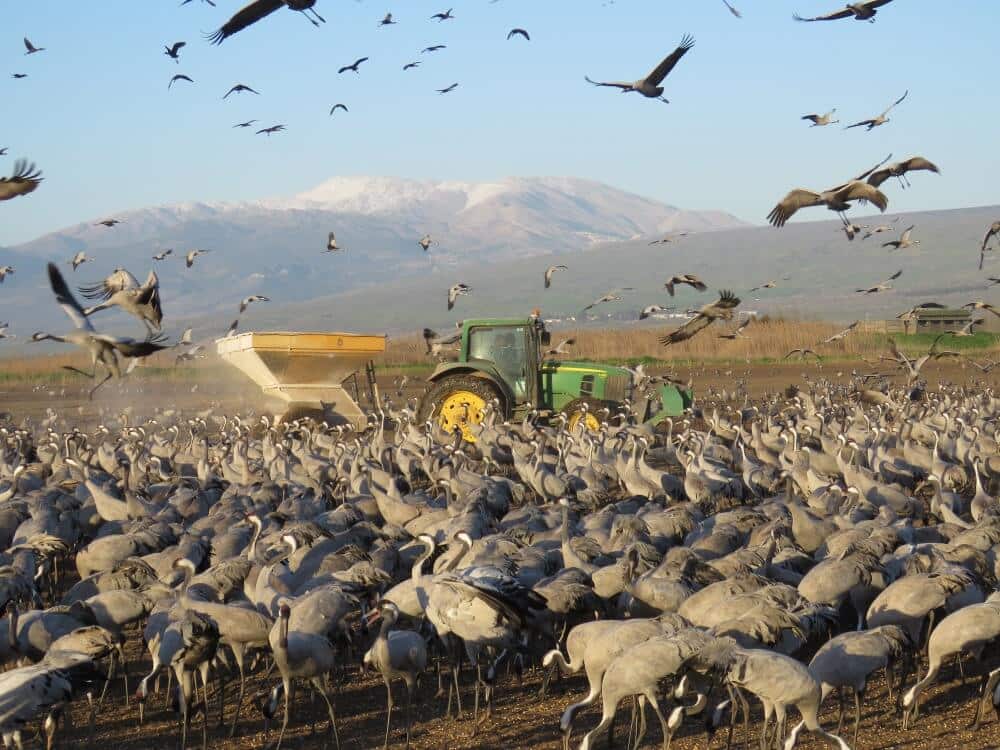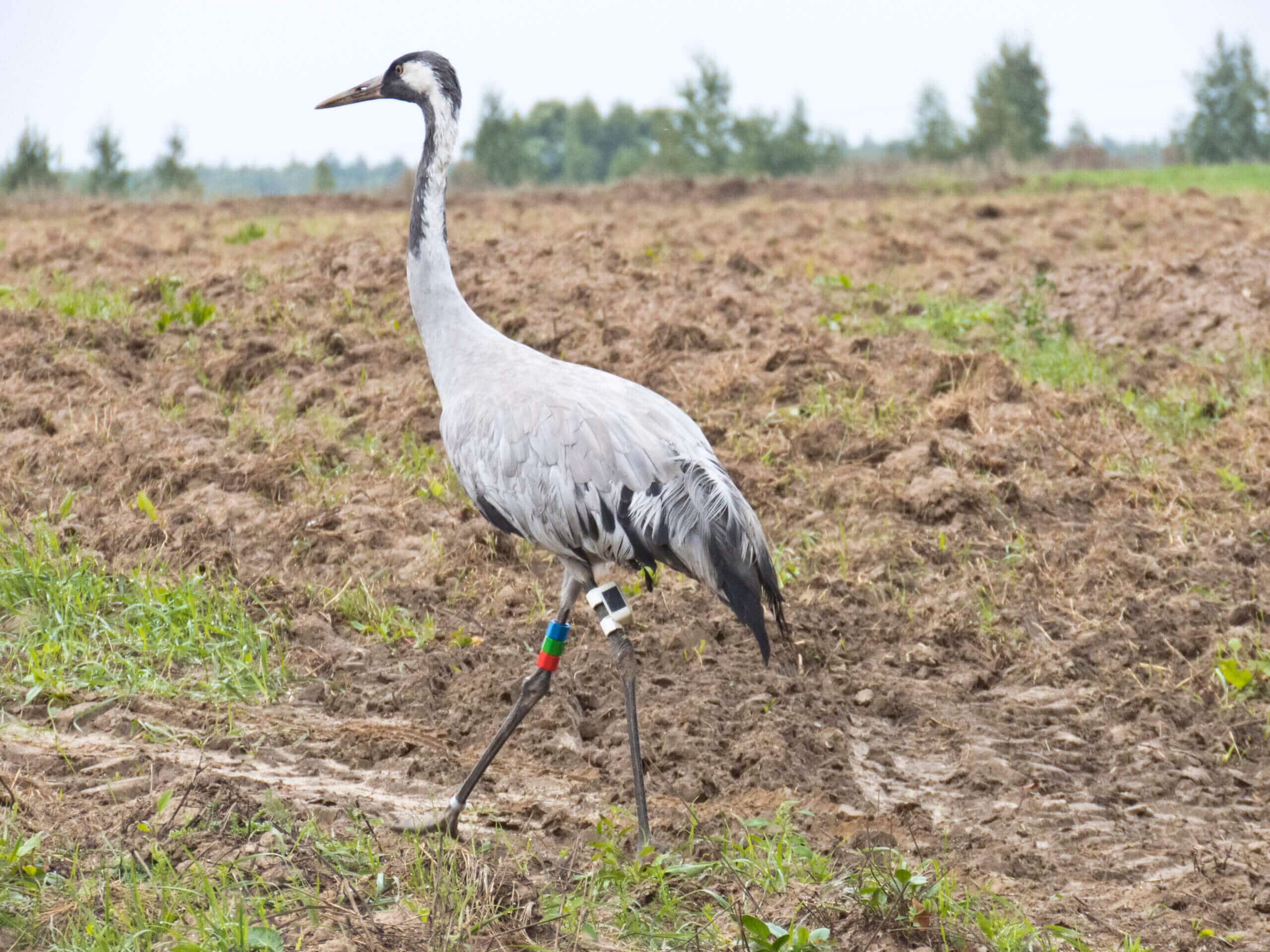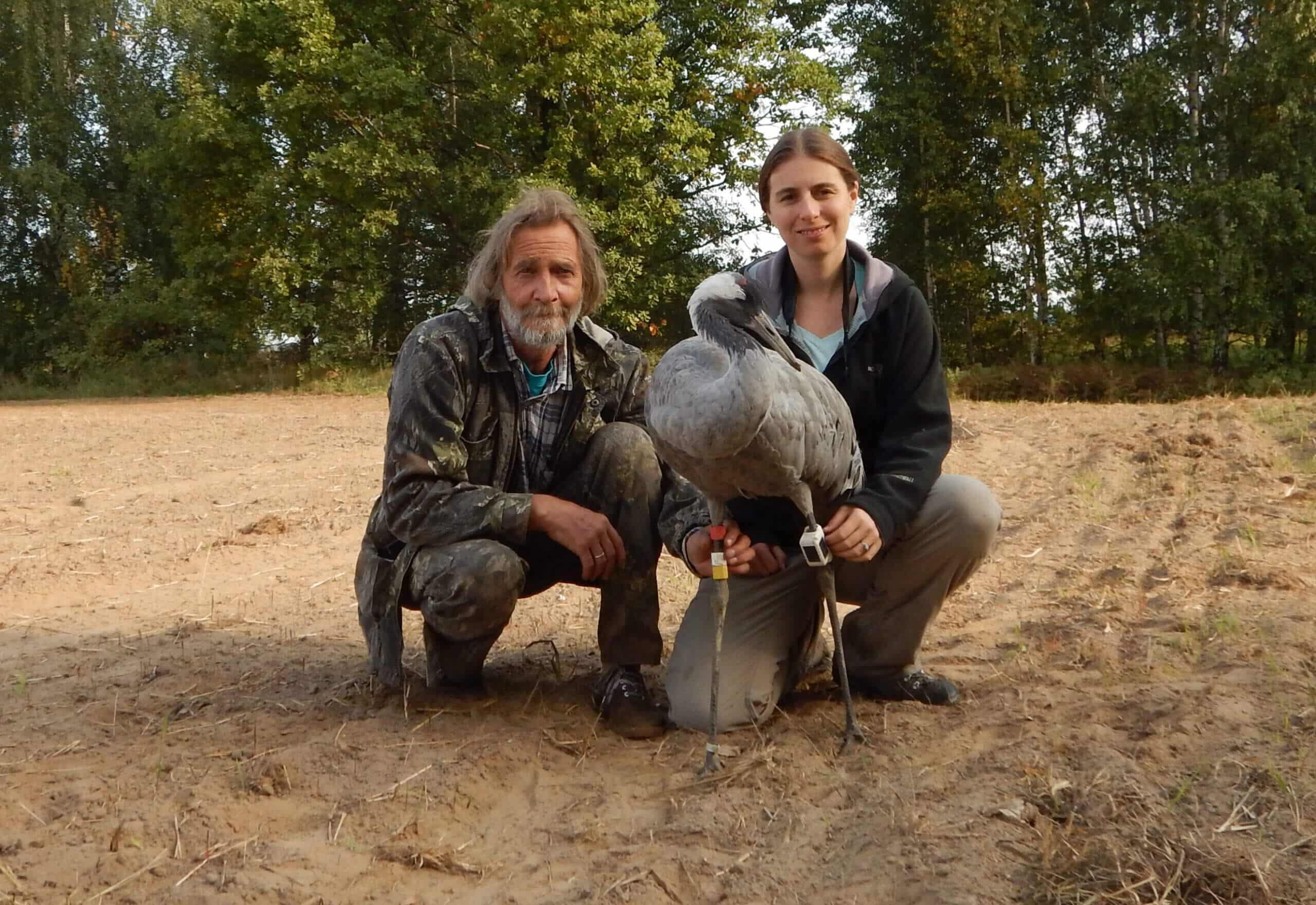Examination of faeces (and movement) of migratory birds, reveals the effect of nutrition on intestinal bacteria. The feeding is of course intended to prevent the birds from raiding the fields
The gray crane is probably the most interesting bird in Israel. Loud flocks of migrating cranes pass through Israel twice a year and tens of thousands of cranes stay here during the winter, mainly in the Hula Valley, and many Israelis flock to see them. A new international study reveals surprising findings about the relationship between the intestinal bacterial community of the gray crane and the habitats and sites where it feeds before and after the migration journey from Russia to Israel

The company of microorganisms (microbiota) that inhabit the digestive system of animals play key roles not only in digestion, but also in the development, health and other features of the animal that stores it. It is also known that the behavior, diet and environment in which the animal lives affect the composition and diversity of the intestinal microbiota. However, most of the existing information in the field originates from research on humans and laboratory and farm animals, and only a few studies so far have been done on wild animals in their natural environment, and in particular on poultry. The difficulty in studying free animals in their natural environment stems from the little information that can be gathered about the diet and behavior of the animals from which the microbiota is sampled, and the difficulty in quantifying and controlling the effect of the variety of conditions to which the individual is exposed in its natural environment.
In a new study, conducted under the leadership of Sasha Pekarsky, who investigates the migration of cranes in the Movement Ecology Laboratory in the Department of Ecology, Evolution and Behavior at the Hebrew University, as part of her doctoral thesis under the direction of Prof. Ran Natan, head of the laboratory and director of the Minerva Center for Movement Ecology at the Hebrew University, 148 samples of (bird excrement) Gray cranes in different areas and times: in Russia before migration, in Israel after migration and in winter in two areas in Israel, only one of them has a feeding station. At the same time, the movement of the cranes was monitored with the help of GPS transmitters attached to 29 cranes, from which it was possible to learn about the cranes' selection of feeding sites in the different areas. "For the purpose of sequencing and analyzing the microbiota, crane feces were sampled using a non-invasive method, which does not require capturing wild animals and thus has an advantage. In addition, we tested the movement patterns of individuals from this population with the help of GPS transmitters. "The combination of the two methods makes it possible to examine the change in the variety and composition of the microbiota in the gut of the cranes in relation to the differences in their environment," the researchers explained this week.

The study, which was conducted with food and agriculture, zoology and environmental science researchers from the American Universities of Berkeley and Maine, and another researcher from Russia, was published a few days ago in the leading scientific magazine in the field of "Molecular Ecology".
One of the main issues examined in the study is the effect of the feeding station operated in the Hula Valley in order to keep the cranes away from the sown fields and prevent agricultural damage. This station supplies cranes Homogenous nutrition of corn in the winter months. In other areas where cranes winter in Israel, such as the Jezreel Valley and the Hefer Valley, cranes are not fed. "These differences provided us with a unique opportunity to compare samples of the microbiota in the same population in the Hula Valley before and after the operation of a feeding station, as well as a simultaneous comparison between this population and the populations that winter in geographical proximity that are not exposed to feeding," explains Prof. Natan. The researchers hypothesized that the uniform food given to the cranes at the feeding station would cause a decrease in the diversity of the intestinal microbiota in the population during this period, as was observed in humans who consume a diet that is not diverse enough. The researchers also expected to find a difference in the diversity and composition of the gut microbiota between samples collected before the migration in the nesting areas in Russia and between samples collected after the migration in Israel.

Yuri Markin and Sasha Pekarsky during the capture and transmission of cranes in Russia. A white GPS transmitter and colored marking rings are visible on the legs of the captured and transmitted crane.
Using the data from the crane transmitters, the researchers found thatin Russia In the fall (before migration), the cranes forage for food in agricultural fields and natural areas, the relative extent of which in Russia is greater than in Israel. Accordingly, the cranes in Russia cause minimal damage to agriculture. Most of the cranes broadcast from Russia migrated in the fall toIsrael And most of them settled in the fall in the sick valley, and stayed in this area throughout the winter. A small part of the broadcast cranes were in Israel outside the sick valley, in the Jezreel Valley, Hefer Valley and the Western Negev. In the fall, the cranes fed on the remains of agricultural crops left in the fields after the harvest, and during this period the damage to agriculture is relatively small. In winter, on the other hand, the cranes are attracted to the fields where the farmers have sown new crops and the damage to agriculture is heavy.
To reduce the damage, it is activated in the Hula valley at the beginning of winter feeding station whose purpose is to attract the cranes and thus prevent nutrition in the fields. The analysis of the effects of the crane interface is detailed in another chapter of Pekarski's doctoral thesis, according to which the feeding station is indeed a center of attraction, and many cranes are there most of their time, but still spend a small part of the time in the fields.
The results of the analysis of the microbiota in the intestines of the cranes showed that the uniform corn diet, which was provided to the cranes at the feeding station in Emek Hula, resulted in a change in the composition The microbiota and especially the growth of the Firmicutes group of bacteria known for its role in breaking down sugars in the intestines of animals. At the same time, contrary to the initial hypothesis, nutrition from this homogeneous source did not result in a general decrease In a variety The microbiota in the cranes feeding at the feeding station compared to samples taken in the Hula Valley in the fall before the station was activated. In addition, it was found that the diversity of the microbiota in the gut of the cranes is higher in areas where there is no feeding during the winter (in the period corresponding to the feeding period in Emek Hula).
Pekarski explained in this context that the decrease in the availability of agricultural manure that remains in the fields in Israel at the beginning of winter encourages the cranes to switch to a more varied diet, based on wild plants and local arthropods. "Our findings indicate that this process causes an increase in the diversity of the microbiota in the cranes outside the Hula Valley, and we assume that such a process also occurs in the Hula Valley, but is 'blocked' by the opposite effect (a decrease in the diversity of the microbiota) that results from the homogeneous food provided at the feeding station during this period. The finding that is particularly surprising is that the cranes that feed on uniform food at the feeding station and are there almost all the time, still manage to diversify their diet in an effective way, despite the very short time they spend on food outside the feeding station!"
Many researchers point out that geographic area strongly influences the microbiota of animals. In this study, on the other hand, no significant difference was found between the cranes sampled in Russia and Israel, despite the great geographical distance, the difference between the habitats where the cranes roost at dawn (in Russia mainly natural areas, in Israel mainly agricultural areas), and the notable difference in times (in Russia before the migration, in Israel after the migration). This surprising finding illustrates why it is important to examine "accepted" hypotheses in the field, and encourages further research to clarify the factors that influence the diversity and composition of the gut microbiota of migratory wild birds.
In conclusion, the researchers note that their research shows that nutrition and movement are of great importance in determining the composition and diversity of the microbiota in wild birds, similar to findings from humans and other mammals. In addition, it seems that the cranes know how to maintain a balanced diet and maintain a diverse bacterial community in the intestine even when they feed mainly on homogeneous food.
More of the topic in Hayadan:
